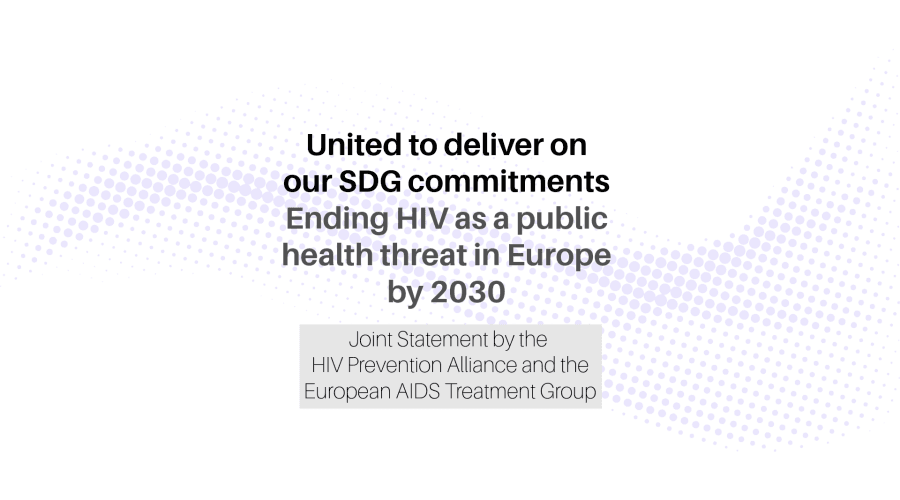
With the increase of new HIV diagnosis over the past few years (12% in 2024), effective HIV combination prevention remains a critical priority across Europe. Despite scientific advances and international commitments to end the HIV epidemic by 2030, far too many people are still unable to access or benefit from the full range of prevention tools available. Structural inequalities, stigma, criminalisation, and exclusion continue to determine who is most at risk, and who is left behind by mainstream health services.
This statement is issued by the HIV Prevention Alliance, a multi-stakeholder initiative bringing together community-led organisations, clinicians, public health experts, and industry, in partnership with the European AIDS Treatment Group. Drawing on the perspectives of both community-led responses and broader health policy, they underline the urgency of closing persistent prevention gaps and ensuring that those most affected are meaningfully included in shaping the response. As highlighted in the French communities’ recent statement Protecting Rights, Preserving Health: A Call to Support Communities in the Fight Against HIV, community services remain indispensable to reaching those most at risk, and ensuring their continuity requires sustained and flexible funding.
A successful HIV response must be grounded in the importance of choice afforded by comprehensive combination prevention. This means ensuring access to a full spectrum of options, from testing, harm reduction services, medical prevention tools and beyond, that can be adapted to people’s different realities. When delivered in ways that are community-rooted and inclusive, prevention services also have the potential to bridge people into broader systems of care and support. Among the tools available today, PrEP has been one of the most transformative as it offers a range of innovative prevention methods options that can give individuals greater control over their health. For those navigating hostile or fragile environments such as migration processes, unstable housing, informal work, or criminalisation, varied PrEP options are therefore also about access, safety, and the right to health.
While the WHO European Region set a regional target to reach 500 000 people receiving PrEP at least once during a year by 2025 and 1 100 000 people by 2030, current data shows that 284 846 people are accessing it (ECDC, 2025). This represents important progress, yet the scale-up remains behind regional goals. These gaps are reinforced when care is not delivered through differentiated, person-centred models, but instead through systems that remain centralised and harder to reach for vulnerable groups or burdened by stigma.
Clinical guidelines play a powerful role in shaping how prevention is understood and implemented. The European AIDS Clinical Society (EACS) has long been a valued ally in advancing HIV care, and we recognise its ongoing efforts to reflect emerging science and best practice. As community advocates, service providers and allies, members of the HIV Prevention Alliance, we encourage continued collaboration and inclusivity in clinical guidelines, to ensure these are informed by the lived experiences of those most affected. We also encourage EACS to continue advancing transformative models of care by exploring and supporting a broader range of PrEP delivery approaches, including those led by communities and provided through non-specialist healthcare settings. Expanding the scope of who can safely deliver different PrEP options presents a valuable opportunity to scale access and better meet the diverse needs of individuals across Europe, and we look forward to collaborating with EACS and other partners to make this a reality when implementing clinical guidelines and beyond.
Finally, we urge European institutions, national governments and key donors to commit to strengthening HIV prevention across the region. This means delivering on SDG commitments, sustaining community funding, and advancing an EU Action Plan for HIV with prevention as a central pillar and appropriate funding for its implementation. To achieve this, communities must be recognised as indispensable partners. Their role in reaching people, shaping effective services, and ensuring accountability is vital to progress. An HIV response that invests in and works with communities, and in partnership with all other relevant actors concerned, will be best placed to deliver lasting and equitable prevention outcomes across Europe.
Download and read the joint statement
List of Alliance Contributors
Adina Manea, Youth for Youth Romania
Alexis Strader, European Health Management Association (EHMA)
Andrea Zanaglio, Gilead Sciences
Arjan Van Der Star, European Public Health Association (EUPHA)
Denis Onyango and Judy Otti, Africa Advocacy Foundation
Dr Cianán Russell, ILGA-Europe
Dr Chloe Orkin, Queen Mary University London
Dr Elske Hoornenborg, Amsterdam University Hospital
Dr Jean-Michel Molina, Paris University
Dr Nicoletta Policek, European AIDS Treatment Group (EATG)
Gonçalo Pinto Mendes, UNITE Network
Heidi Ulrike Siller, European Institute of Women’s Health
Katrin Schiffer, Correlation Network
Koen Block, International Planned Parenthood Federation European Network (IPPF EN)
Lisa Phillippo, European Sex Worker Alliance (ESWA)
Luís Mendão, GAT – Treatment Activist Group
Marc Dixneuf, AIDES
Micheal Meulbroek and Ferran Pujol, BCN Checkpoint
Nici Wertecki, Safer Sex Berlin
Rhon Reynolds, ViiV Healthcare
Samira Hakim, Trans United Europe
Sandro Mattioli, PLUS Bologna
Silas Holland, MSD
Sophie Strachan, Sophia Forum

Materials
Related Press releases and Statements
Get involved
Are you living with HIV/AIDS? Are you part of a community affected by HIV/AIDS and co-infections? Do you work or volunteer in the field? Are you motivated by our cause and interested to support our work?
Subscribe
Stay in the loop and get all the important EATG updates in your inbox with the EATG newsletter. The HIV & co-infections bulletin is your source of handpicked news from the field arriving regularly to your inbox.
